 This article on Finnish Spitz is part of a series to highlight the Big Picture of health, welfare and breeding and to help develop Globally Relevant Integrated Health Profiles (GRIHPs) for many breeds. See IPFD's Get a GRIHP! on Breed Health Initiative.
This article on Finnish Spitz is part of a series to highlight the Big Picture of health, welfare and breeding and to help develop Globally Relevant Integrated Health Profiles (GRIHPs) for many breeds. See IPFD's Get a GRIHP! on Breed Health Initiative.
Visit the Suomen Koiramuseo to  learn about the Finnish Spitz, the oldest of all the Finnish breeds - a dog that has followed the Finnish people since ancient times.
learn about the Finnish Spitz, the oldest of all the Finnish breeds - a dog that has followed the Finnish people since ancient times.
Many thanks to Katariina Mäki for pulling together the content presented in this Finnish Spitz GRIHP article and to Kaisa Huttunen for providing photos of the dogs.
Table of Contents
Breed At a Glance - Finnish Spitz
The national dog of Finland, Finnish Spitz is a model for success in terms of execution of a breed-specific breeding strategy. Known as Suomenpystykorva in Finland, the Finnish Spitz is one of the healthiest dog breeds, and the Finns want to keep it as such for future generations. The dogs can be expected to live to > 11 to 15 years of age. The Finnish breed association estimates that the worldwide living population of the Finnish Spitz is somewhere in the range of 13,000 – 15,000 dogs. The breed is relatively rare outside of Finland and neighboring Scandinavian countries.
Goal-oriented breeding of the Finnish Spitz, started officially in 1892, when the first breed standard of a “Finnish barking bird dog” was written. The breeding goal was to develop a skillful dog, who barks at birds perched in trees, and who at the same time is also a beautiful yard dog.  A Finnish Spitz dog uses its voice to indicate the location of game. Today the dogs are used to hunt forest game birds, but also to some extent serve as an elk-hunting dog as well as to hunt small game and retrieve birds shot into the water.
A Finnish Spitz dog uses its voice to indicate the location of game. Today the dogs are used to hunt forest game birds, but also to some extent serve as an elk-hunting dog as well as to hunt small game and retrieve birds shot into the water.
The most important breeding goals along with good health are to retain the breed's current bird-barking characteristics without forgetting its diverse potential as a versatile hunting dog. The Finnish Spitz is a designated hunting dog, so its mental make-up and other properties must be up to this task. Today behaviour of the Finnish Spitz dogs corresponds quite well to the breed standard. Finnish Spitz can nowadays be an excellent pet for the whole family.
Key Health Conditions - The Basics: Finnish Spitz
Finnish Spitz is a relatively healthy dog breed. Key inherited health conditions include patella luxation, missing teeth, eye diseases (cataracts and PHTVL/PHPV) and epilepsy. The breed has also had problems with reproduction.
Epilepsy has been the focus of significant attention in this breed and the effort has yielded significant results.
(See more under the Health and Breeding section.)
What do Caretakers of Finnish Spitz need to Know?
The Finnish Spitz is suitable family pet for active people. The dogs do especially well with a person who hunts or spends a great deal of time outdoors in nature. The breed requires a lot of exercise and attention.
The breed standard describes Finnish Spitz as lively, energetic, brave, stubborn and enduring. It may be a little reserved for strangers, but it must not be aggressive. The mentality of the dogs today corresponds very well to the standard. The breed has a moderate guard instinct. A large proportion of the dogs do not accept an unknown person approaching its' owner's belongings, car and yard when the owner is not at home. The dogs warn an oncoming person by barking.
Statistics and Health Strategies
Population Statistics
Comment: Based on registration numbers from abroad, the Finnish breed association estimates that the worldwide living population of the Finnish Spitz in the range of 13,000 – 15,000 dogs. The largest population is in Finland, and the populations in the neighboring countries are also quite numerous.
There was a long-lasting trend of decreasing registrations in Finland and Sweden, but during the recent years, the trend seems to have turned positive. This is mostly thanks to the active breed clubs and the work they have done in breeding a dog for the whole family.


The breed has made its way to North America - but not in large numbers.
AKC registration rank in 2020 was 187 out of 195 breeds which clearly confers rare-breed status. Canadian Kennel Club registrations are shown below.

Health & Breeding Statistics
Agria - Swedish Breed Profiles

CONTEXT: For many years, Agria Animal Insurance, Sweden (Agria Djurförsäkring, Stockholm, Sweden) has supported veterinary research and provided statistics on diagnoses for health and life claims to Swedish breed clubs. See Breeds with Swedish Insurance Data and Agria Breed Profiles (where breeds are compared to All Breeds)! We recommend that you download the Agria Breed Profiles for the Finnish Spitz and study them for full available information. Some excerpts are shown below! The great benefits of the Swedish insurance data are that they include almost 40% of the national population of dogs, so are very representative; note that animals at very old ages are likely under-represented. Most importantly, information is available on all insured dogs, not simply those who get sick or die. This allows calculation of population-based rates (expressed as events per 10,000 years-at-risk) as well as risks and proportions. Statistics are presented as overall morbidity (rate of one or more veterinary care events [VCE]) or mortality (death), by general diagnostic categories, and by specific diagnoses.
Agria Breed Statistics 2006-2011 and Agria Breed Statistics 2011-2016
The Charts shown below from the 2011-2016 Agria Breed Profile for Finnish Spitz clearly show Veterinary Care Events (VCEs) for Finnish Spitz are not as common across various health conditions as are VCEs for All Breeds.


The most common reason for vet care in Swedish Finnish Spitz dogs in 2011-2016 was snake/insect bite. Compared to all breeds, the risk was high also for cough, upper respiratory problems, pneumonia, knee/patella problems, and cesarean section.

The most common cause of death of the breed in Agria data 2006-2011 (=Swedish dogs) was diabetes. According to the Finnish breed club's health survey (2010) and the Finnish Kennel Club breeding database, diabetes made up about 3% of all reported causes of death. It seems, however, that diabetes is mostly a problem in older dogs.

The cases of deaths due to diabetes in 2011-2016 was fewer than 8 cases and therefore not reported due to GDPR considerations. It can be said, however, that the relative risk for death in Finnish Spitz compared to All Breeds, for diabetes was lower than in 2006-2011 (less than 4.5, B. Bonnett, personal communication). The only reportable condition was hit by car/train/vehicle with a Relative Risk of 1.5 and a median age at death of 5 compared to 3 years of age for All Breeds.
Finnish Spitz have low death rates in most categories and a higher age at death. Finnish Spitz have comparable rates and ages for death due to injury.

Finnish Spitz had a relative risk for death of 0.59 - in other words, they were 1.7 times less likely to die in the period compared to All Breeds.

Finnish Spitz - Breed Specific Breeding Strategies
Comment: Due to the concentration of Finnish Spitz primarily in Finland and Scandinavia we will focus on presentation of health and breeding strategies utilized in that region of the world. There is longstanding cooperation and sharing of resources and health information for breeds between Kennel and Breed Clubs that are members of the Nordic Kennel Union. Health screening tests as well as other important breed management considerations are outlined in the Finnish JTO and PEVISA and the Swedish and Norwegian RAS documents. Please see links to these resources for the Finnish Spitz as well as excerpted content below.
What are the RAS, JTO and PEVISA?
A RAS or JTO is a breed-specific breeding strategy based on evidence and information gathered from a range of sources. Hence, the breeding plan should be tailored to the conditions of the individual breed and consider all aspects relevant in the breeding goal for that breed, i.e., physical and mental health, working traits as well as population structure and genetic variation. The documents contain the history of the breeds, a description of the present situation, and goals and strategies for the future. The idea is that the document should constitute an overall plan for the breed and act as a guideline to breeders.
PEVISA is Finnish and short for "perinnöllisten vikojen ja sairauksien vastustamisohjelma", which translates as "programme against hereditary defects and diseases". Aimed at breeders and breed associations, it includes breeding dog health requirements for breed-specific registration conditions. Also use of inbreeding and popular sires can be limited with the program. The PEVISA regulations vary from breed to breed, and are usually updated every five years for each breed.
Among other things, these programmes aim to ensure that hereditary diseases commonly occurring in a breed are taken under control and that their spread is prevented. Breed associations apply for a PEVISA programme to be authorised for their breed and they are responsible for monitoring the programme's impact. Breed associations and their subordinate clubs are similarly responsible for steering the breeding in their respective breeds as well as for their breed's JTO/RAS.
NEW - December 2021
The following article by Katariina Mäki (2021) offers in-depth information on development of the Finnish Spitz Breeding Strategy. The article, Breed-specific breeding strategies to achieve positive outcomes - the Finnish Spitz as an example, is presented in 3 parts.
Part I. Tackling the main health conditions
Part II. Success story regarding epilepsy
Part III. Increasing and maintaining genetic diversity
Health Screening Tests for Finnish Spitz
Comments: Maintaining the good health of the breed is the most important breeding goal. Individuals transmitting hereditary problems should be culled from breeding without reducing the gene pool too much.
Health Tests/Screening: Finland, Sweden & Norway
-
Veterinary patella examination - Finland mandatory (PEVISA) and Norway recommended for Finnish Spitz breeding dogs in order to get their offspring registered or approved by the breed club. In Norway the diagnosis has to be 0 (normal); in Finland the grade I (almost normal) is allowed. If one parent has a grade I luxation, the other one should have grade 0 (normal patellas). Sweden recommends patella examination be done.
-
Notes: Patella luxation: Susceptibility increases with a build, in which the long bones of the hind leg are convoluted respective to each other, the trochlear groove is shallow and the entire knee angle is too open. The structure of the hind leg is a hereditary trait, which can be influenced through breeding.
Prevalence notes: Of the dogs registered in Finland during 2010 - 2019, 26 % have been examined. Of these, 92 % were normal, 5 % had 1-degree and 2 % 2-degree luxation, when the scale is 0-4 (See Figures below). In Sweden during the same period, the proportion of normal patellas has been somewhat higher, varying between 95 % and 100 %. The examination protocol differs slightly: in Sweden, the scale used is 0-3.
In the light of the patella luxation statistics the situation in Finland is good, and in Sweden even better. However, the proportions of examined dogs are quite small. In addition, the Finnish breed club has been informed of cases in which a young dog has been euthanized or has had to undergo surgery before the age of examination (12 months) because of strong symptoms. The breed club is gathering info on dogs which have been treated because of knee problems.
-

-
Sweden:
(föräldradjur - kombinationer kullar födda = parent animals - combinations litters born; ua = normal patellas; okänt = patella status of the dog not known; Andel = proportion)
-

-
Veterinary eye examination - Finland mandatory (PEVISA) and Norway recommended for Finnish Spitz dogs in order to get their offspring registered or approved by the breed club. Finland: Hereditary cataract, PRA, or PHTVL/PHPV (grades 2-6) not allowed. If one parent has grade 1 PHTVL/PHPV, the other one should be free of PHTVL/PHPV. Eye examinations of the Finnish Spitz dogs are not yet common in Sweden.
-
Prevalence notes: Eye diseases
-
The most common eye diseases in the breed are different cataracts as well as PHTVL/PHPV. During the 2010s, cataracts have been found in approximately 5% and PHTVL/PHPV (grades 2-6) in approximately 2.5 % of the dogs examined in Finland. The yearly proportion of examined dogs varies between 25-35 % of all registered dogs. In Norway, out of 13 individuals examined during 2020, 5 dogs were diagnosed with hereditary cataract.
Strategies for Other Conditions
Missing teeth
All Nordic breed clubs are gathering info on tooth problems in individual dogs. The recommendation is to use dogs with only mild teeth problems for breeding and to mate them with a partner, which has a full set of teeth.
Prevalence notes: 14,8 % of the dogs had one or several missing teeth (2019 health survey of the Finnish Kennel Club). Most commonly, 1-3 premolars (P2 and P3) were missing, but several missing teeth were also reported, including molars.
Sweden - below is the number of individuals with a dental status certificate issued by a veterinarian. The year is the one when the dental status was registered by the breed club.
(År = year; Tänder UA = normal teeth; Saknar = missing teeth)

Epilepsy
Breed clubs in Finland, Sweden and Norway collaborate in reporting epilepsy cases and by this, contributing to the estimation of so called epilepsy index for the dogs in the breed. The index is based on the information of epileptic relatives in each dog's pedigree. In Finland, epileptic dogs are recorded in an open database where epi-indices are included in the pedigrees, together with notations explaining which relatives account for the index: http://metsastyspystykorvat.com/spj/.
Epi-index is calculated from a five-generation pedigree, taking into account the genetic relationships between the dog and its epileptic ancestors. The index has been an effective tool in breeding: strong improvement can be seen starting from the year 2001, when the breeding advisors of the association started to use the indices. Read more about the index from the Finnish breed club's breeding strategy document (JTO).
Prevalence notes: Finland - the frequency of epilepsy has fallen down from the early 2000s' 5-6 %. Currently, the breed club doesn't publish the numbers anymore, but keeps a close eye on the situation. Sweden - the last two cases so far were reported in 2016:

The Agria data for 2006-2011 and 2011-2016 show that compared to all breeds, Finnish Spitz has a smaller risk for epilepsy (see charts above).
The management to reduce the incidence of epilepsy in Finnish Spitz is quite well done for a breed which formerly used to be one of the typical epileptic breeds!
About epilepsy seizures in Finnish Spitz: On average, epileptic Finnish Spitz dogs suffer their first seizures at the age of three, get on average three seizures per year and the typical length of a seizure is 12 minutes. Partial seizures, which are commonly associated with behavioural changes and autonomous symptoms like vomiting and drooling, are typical for the breed. More frequent occurrence of seizures can indicate progression of epilepsy, although the course of epilepsy is usually benign.
Reproduction
Dams, which resist mounting, or sires that are repeatedly reluctant to mount even though the timing is confirmed to be correct must not be used for mating if even a switch in partners fails to produce the desired end result. Nor should artificial insemination be used in such cases (The Finnish breed club). A breeding bitch must have the ability to give birth normally. Dogs that cannot give birth normally should not be used in breeding. Dogs to be bred on should be able to mate naturally (Norwegian breed club).
Further information: Finland: Problems occur in whelping as well as females getting pregnant. Litters have been relatively small. However, litter size is currently increasing slowly, at the same pace with a decreasing average inbreeding coefficient. This phenomenon is visible also in the Swedish population of the breed (Swedish RAS). Inbreeding may have been the reason for the reproduction problems in the breed. Another reason is probably the relatively high age of the breeding females.

See more on Reproduction matters under the Genetic Diversity Section below.
Longevity
 In the Finnish Kennel Club breeding database the average life span (of the dogs which have been reported as dead during 2011-2021) of the Finnish Spitz is 11 years 3 months. Dogs, whose cause of death was reported to be an old age, had an average lifespan of 13 years and 6 months (see the table below). Typical for a hunting dog is that quite many (99) dogs died in an accident. These accidents include the disappearance of the dog, as well as hitting by a car or other vehicle, as can be seen from the Agria data above.
In the Finnish Kennel Club breeding database the average life span (of the dogs which have been reported as dead during 2011-2021) of the Finnish Spitz is 11 years 3 months. Dogs, whose cause of death was reported to be an old age, had an average lifespan of 13 years and 6 months (see the table below). Typical for a hunting dog is that quite many (99) dogs died in an accident. These accidents include the disappearance of the dog, as well as hitting by a car or other vehicle, as can be seen from the Agria data above.

HGTD DNA Tests for Finnish Spitz
The Harmonization of Genetic Testing for Dogs (HGTD) Basics: The HGTD Searchable Database - Search by Breed, Search by Disease / Test and Search by Genetic Test Provider (GTP) / Lab + Genetic Counselling Resources. HGTD catalogs information provided voluntarily from genetic test providers (GTPs) including information on their company and services, quality measures and expertise, tests offered and more. As of January 2021, the HGTD Database includes 82 academic and commercial genetic test providers (GTPs) in 22 countries. Our searchable genetic phenes (phenes = characteristics/genetically controlled feature) database currently holds information on 300+ phenes across all breeds/types and provides information on each phene: links to the Online Mendelian Inheritance in Animals database (OMIA), gene + mutations, a simple and advanced disease description, inheritance details, links to original publications, patents/licenses, comments from the original researchers/experts on application, and breed specific information (such as research/validation) - where possible. Breed Relevance Ratings (BRR) support evidence-based usage and application of genetic tests. The HGTD database relevance rating indicates the level of available evidence supporting the application of a specific genetic test for a specific breed/type. Currently, the relevance rating is based on a wide variety of evidence sources. This includes peer-reviewed research papers, recommendations from the original researchers/test developers, input from additional experts including veterinary specialists, and breed experts. It is hoped that, by being more informative about what we currently know or do not know about a specific test for a specific breed, that dog health advisors and owners can make more informed decisions. Remember, this Breed Relevance Rating is not everything we need to know about the disease or characteristic; it is focused on the genetic test.
SUMMARY: At this time there are no relevant Genetic Disease/Disorder DNA Tests for the Finnish Spitz. A few 'Trait' and Parentage tests may be relevant.
HGTD - Finnish Spitz
Genetic Diversity in the Finnish Spitz - Research & Reports
To widen the gene pool, the cross-border Russian population that is, according to local estimates, growing strongly, was added to the Finnish Spitz population in 2006.
According to the research by Kumpulainen et al. (2017), the genetic diversity of the Finnish Spitz is still low: "We found that the Finnish Spitz has undergone repeated male bottlenecks resulting in dramatic loss of genetic diversity, reflected by 20 effective founders (fa) and mean heterozygosity (Hz) of 0.313. The realized effective population size in the breed based on pedigree analysis ( ) is 168, whereas the genetic effective population size (Neg) computed the decay of linkage disequilibrium (r2) is only 57 individuals."
) is 168, whereas the genetic effective population size (Neg) computed the decay of linkage disequilibrium (r2) is only 57 individuals."
The ratio of sires and dams has increased during the 2000th century both in Finland and Sweden. It is slowly approaching the (usually theoretical) optimal situation where the numbers of breeding males and females are equal. Positive trend indicates better utilization of male dogs and reduced risks of "matador breeding". Having a ratio as equal as possible is one of the best ways to maintain genetic diversity in a closed gene pool.
Inbreeding affects reproduction as was mentioned earlier. Both in Finland and Sweden the average (short term) inbreeding coefficient is decreasing, and at the same time the average litter size is growing. Increasing genetic diversity will likely have positive effects to all reproduction traits of the breed.


Sweden:
(Inavelsgrad = inbreeding coefficient; kullstorlek = litter size; Antal valpar/procent = Number of puppies/percent; genomsnitt = on average; Linjär = trend)

Genetic Diversity Notes: The Nordic breed clubs have worked effectively for years to widen the gene pool of the breed. They have introduced maximum limits for the numbers of offspring per individual dogs as well as for the inbreeding coefficient of the litters. They have also encouraged owners to use their dogs for breeding and thus to increase the number of breeding dogs in the breed.
From the beginning of 2009, at most 70 offspring could be registered in Finland for an individual dog in this breed. The number of registrable offspring was lowered to 50 as of the beginning of 2016. In Sweden, the maximum recommended number of offspring is set at maximum 20% (preferably not more than 10%) of the number of all registered Finnish Spitz puppies per year, and in Norway, 5% of the number of registered Finnish Spitz puppies per 5 years. This is to avoid popular sires and their shrinking effect to the gene pool.
A maximum limit is set also to the inbreeding coefficient of litters. In Finland and Sweden, the limit is 6.25% (calculated from 7 generations in Finland and 5 generations in Sweden) and in Norway 4%. In Finland litters with higher inbreeding coefficient will not be registered at all (PEVISA). In Sweden and Norway the limit is a recommendation.
The Swedish breed club has a system for broaden the gene pool by introducing more male dogs in breeding. They have a list of males which meet the requirements regarding health, hunting traits and exterior. To allow for more diverse use of males in breeding, they have an additional list with the same requirements, except for hunting and show merit. These dogs may be used for 1-2 matings. After 1-2 litters they should have at least a 2nd prize on hunting trials, to be able to sire more litters.
Examples of additional recommendations
-
Dogs that suffer from a clear sound phobia or are vicious must not be used for breeding.
-
Neither diabetic nor dogs that produce diabetic offspring should be used for breeding. Nor should two such lines be combined, both of which are known to have diabetic dogs.
-
Dogs aged under four years are recommended to have at most two litters, and dogs under two years are not yet recommended for breeding. Also bitches are recommended to reach an age of two years before the first litter (Finnish breed club).
History
 ★ Go to The Finnish Canine Museum ★
★ Go to The Finnish Canine Museum ★

References and Resources
Finnish Breed Club: Suomen Pystykorvajärjestö https://spj.fi/rodut/suomenpystykorva/jalostus/jalostus/
Finnish JTO (2021 - draft, to be added when approved by the breed club and the FKC)
Norwegian breed club: Norsk Spesialklubb for Finsk Spets og Norrbottenspets https://www.nsfn.no/index.php/avl/avlskriterier
Swedish breed club: Specialklubben för Skällande Fågelhundar https://ssf-riks.se/avelsradfs/
Swedish RAS 2021: https://ssf-riks.se/wp-content/uploads/2021/04/RAS_Finsk_spets_2021.pdf
Swedish breed club, Breeding report 2019: https://ssf-riks.se/wp-content/uploads/2020/04/Verksamhetsberattelse-2019.pdf (Internal: Verksamhetsberattelse-2019.pdf)
Founder representation and effective population size in old versus young breeds—genetic diversity of Finnish and Nordic Spitz; M. Kumpulainen H. Anderson T. Svevar I. Kangasvuo J. Donner J. Pohjoismäki. First published: 10 March 2017. https://doi.org/10.1111/jbg.12262 (Internal: Spitz-uef(1).pdf)
Viitmaa 2013. Idiopathic epilepsy in Finnish Spitz dogs : Epidemiological, clinical and diagnostic aspects. PhD Dissertation, University of Helsinki. (Internal: viitmaa_ranno.pdf)
Epilepsy index (in Finnish): http://spj.fi/rodut/suomenpystykorva/terveys/epi-luku/. For English, see the Summary of the Breed-Specific Breeding Program (JTO) Finnish Spitz -- 2016-2020 and for Swedish, the RAS (link above).
DogWellNet Resources
DWN's Pedigreed Dogs Database: Finnish Spitz
Illustrated Standards-Study Guides/Compendiums
Specialklubben för Skällande Fågelhundar Raskompendium för FINSK SPETS
Internal (retained for archiving purposes) finsk_spets_2016.pdf
Finnish Spitz (FCI General Committee, Helsinki, October 2013)-(FCI Show Judges Commission, Cartagena, February 2013)
Internal (retained for archiving purposes)049g05-PRE-en.pdf
Finnish Spitz Club of America - Judges Education PowerPoint
Internal (retained for archiving purposes) Finnish Spitz - fsca_seminar_2016
Database Resources
Sweden: SKK HUNDDATA: https://hundar.skk.se/hunddata/
Sweden: SKK AVELSDATA: https://hundar.skk.se/avelsdata/Initial.aspx
Finland: Jalostustietojärjestelmä | Suomen Kennelliitto: Finnish Kennel Club: https://jalostus.kennelliitto.fi/frmEtusivu.aspx?Lang=en&R=253
Norway: Dogweb: https://www.dogweb.no/dogweb/dw/openPage/hoved.html
France: SCC: Lof Select: https://www.centrale-canine.fr/lofselect
UK: The Kennel Club: Mate Select: https://www.thekennelclub.org.uk/services/public/mateselect/
IPFD and The World Small Animal Veterinary Association
See our series of Meet the Breed articles in the WSAVA Bulletin and associated Get a GRIHP! Articles on DogWellNet.com:
-
Welsh Corgi
-
Dachshund
-
French Bulldog


-
Australian Shepherd
-
Saluki
-
Golden Retriever
-
Bernese Mountain Dog
-
Black Russian Terrier
-
Pug
-
Finnish Spitz
-
Rhodesian Ridgeback
-
Rottweiler
-
Whippet
-
Belgian Shepherd
-
English Bulldog
-
Irish Soft Coated Wheaten Terrier
-
Dalmatian
-
Border Terrier
-
Staffordshire Bull Terrier
-
Siberian Husky
-
Dobermann
-
Shih Tzu
-
English Setter
-
Beagle
-
Chihuahua

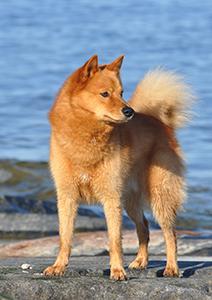 This article on Finnish Spitz is part of a series to highlight the Big Picture of health, welfare and breeding and to help develop Globally Relevant Integrated Health Profiles (GRIHPs) for many breeds. See IPFD's Get a GRIHP! on Breed Health Initiative.
This article on Finnish Spitz is part of a series to highlight the Big Picture of health, welfare and breeding and to help develop Globally Relevant Integrated Health Profiles (GRIHPs) for many breeds. See IPFD's Get a GRIHP! on Breed Health Initiative.
 learn about the Finnish Spitz, the oldest of all the Finnish breeds - a dog that has followed the Finnish people since ancient times.
learn about the Finnish Spitz, the oldest of all the Finnish breeds - a dog that has followed the Finnish people since ancient times.
 Donate
Donate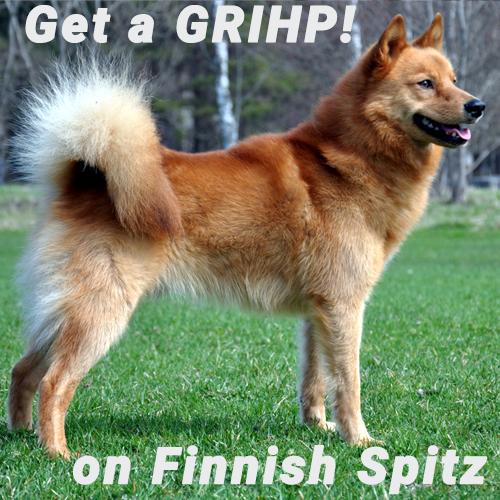

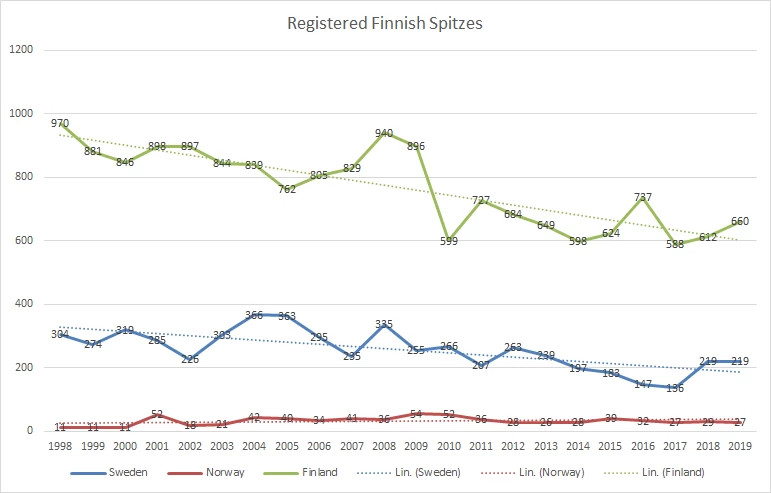
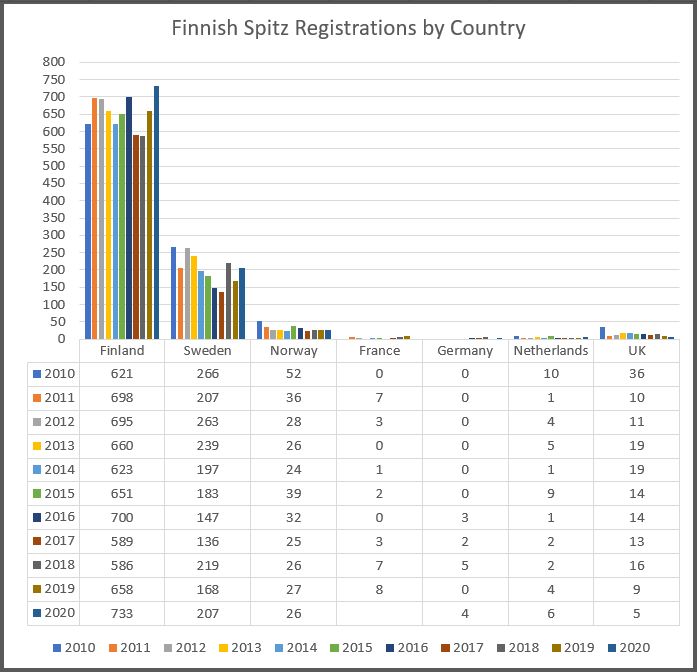




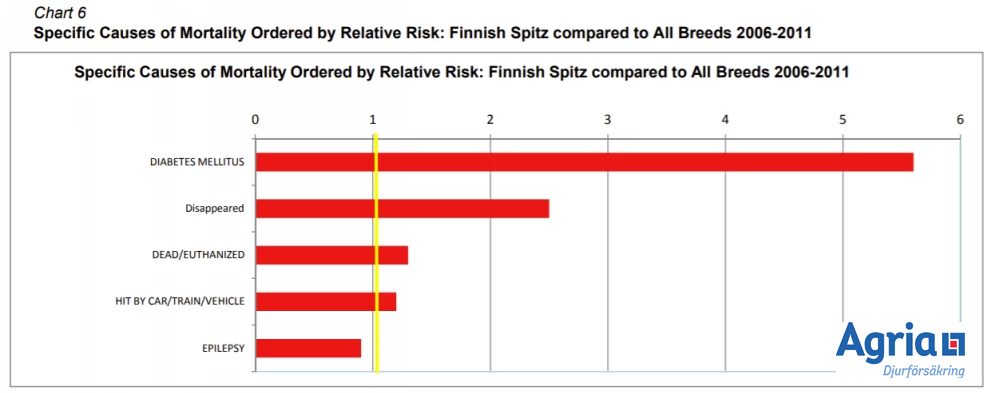
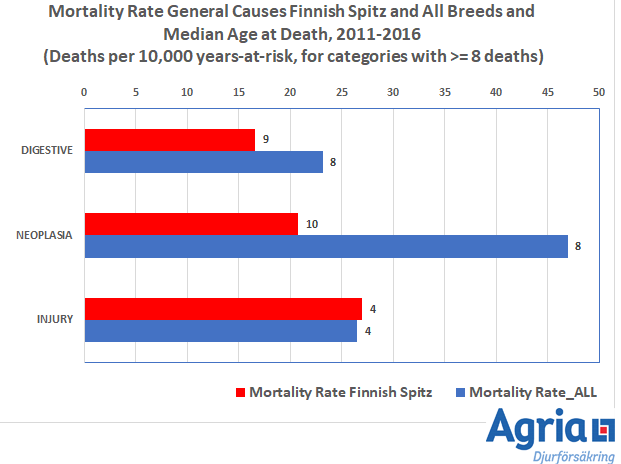
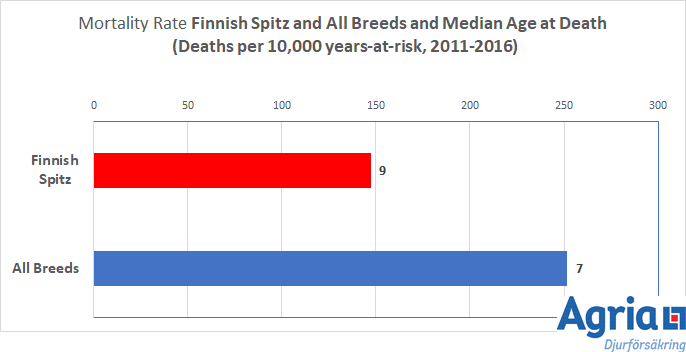
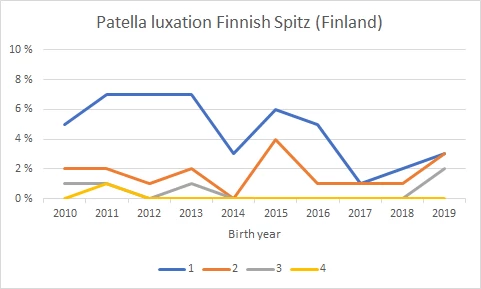
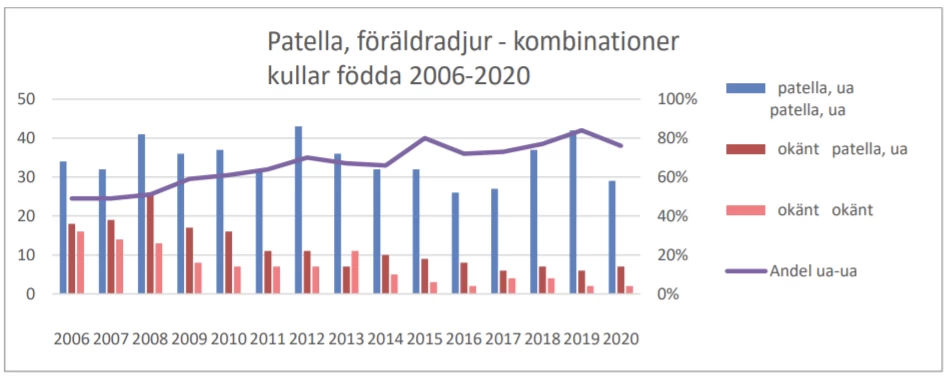


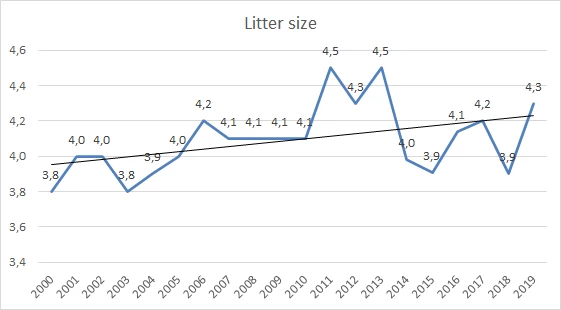
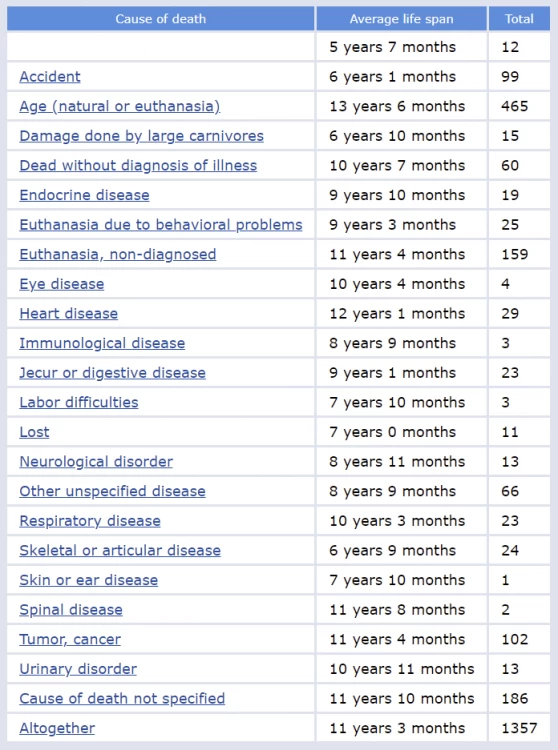 In the Finnish Kennel Club breeding database the average life span (of the dogs which have been reported as dead during 2011-2021) of the Finnish Spitz is 11 years 3 months. Dogs, whose cause of death was reported to be an old age, had an average lifespan of 13 years and 6 months (see the table below). Typical for a hunting dog is that quite many (99) dogs died in an accident. These accidents include the disappearance of the dog, as well as hitting by a car or other vehicle, as can be seen from the Agria data above.
In the Finnish Kennel Club breeding database the average life span (of the dogs which have been reported as dead during 2011-2021) of the Finnish Spitz is 11 years 3 months. Dogs, whose cause of death was reported to be an old age, had an average lifespan of 13 years and 6 months (see the table below). Typical for a hunting dog is that quite many (99) dogs died in an accident. These accidents include the disappearance of the dog, as well as hitting by a car or other vehicle, as can be seen from the Agria data above.
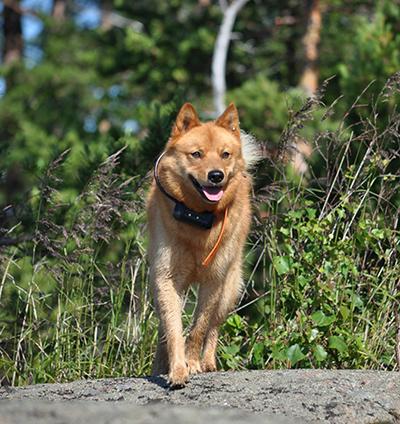
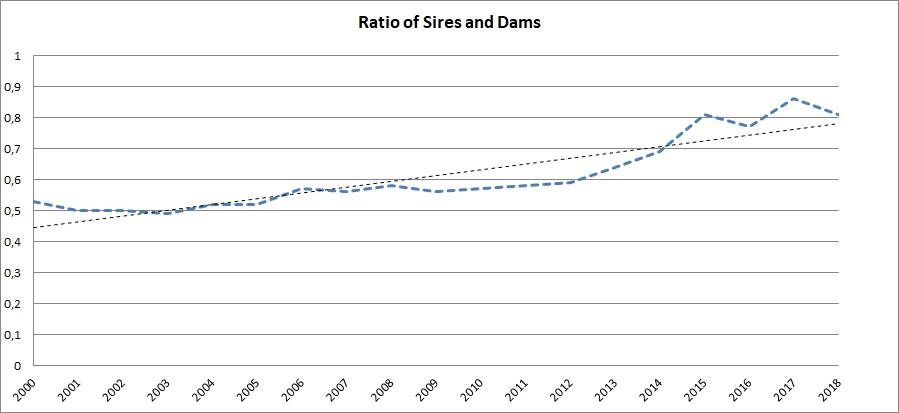

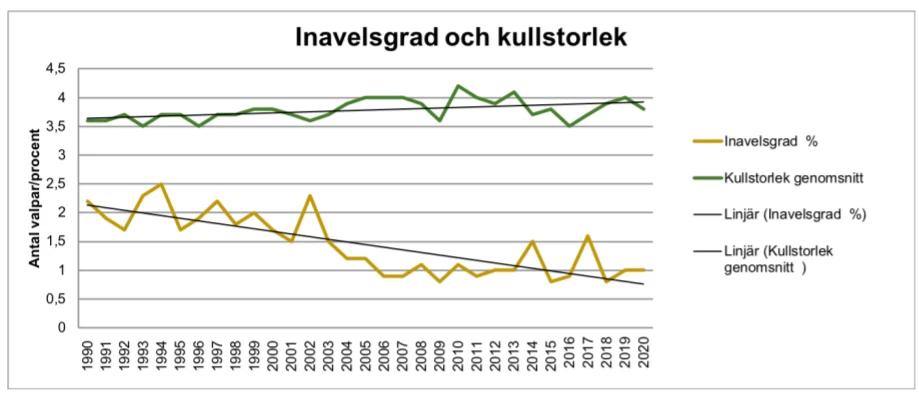
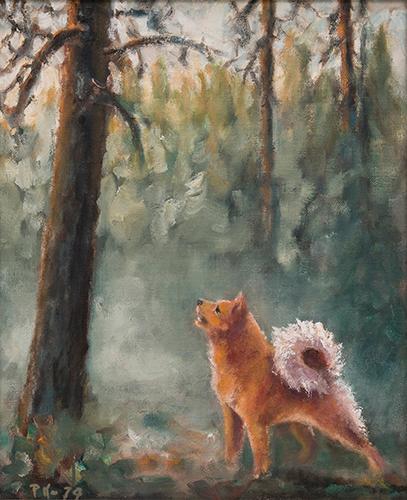 ★
★ 



Recommended Comments
There are no comments to display.
Join the conversation
You can post now and register later. If you have an account, sign in now to post with your account.
Note: Your post will require moderator approval before it will be visible.